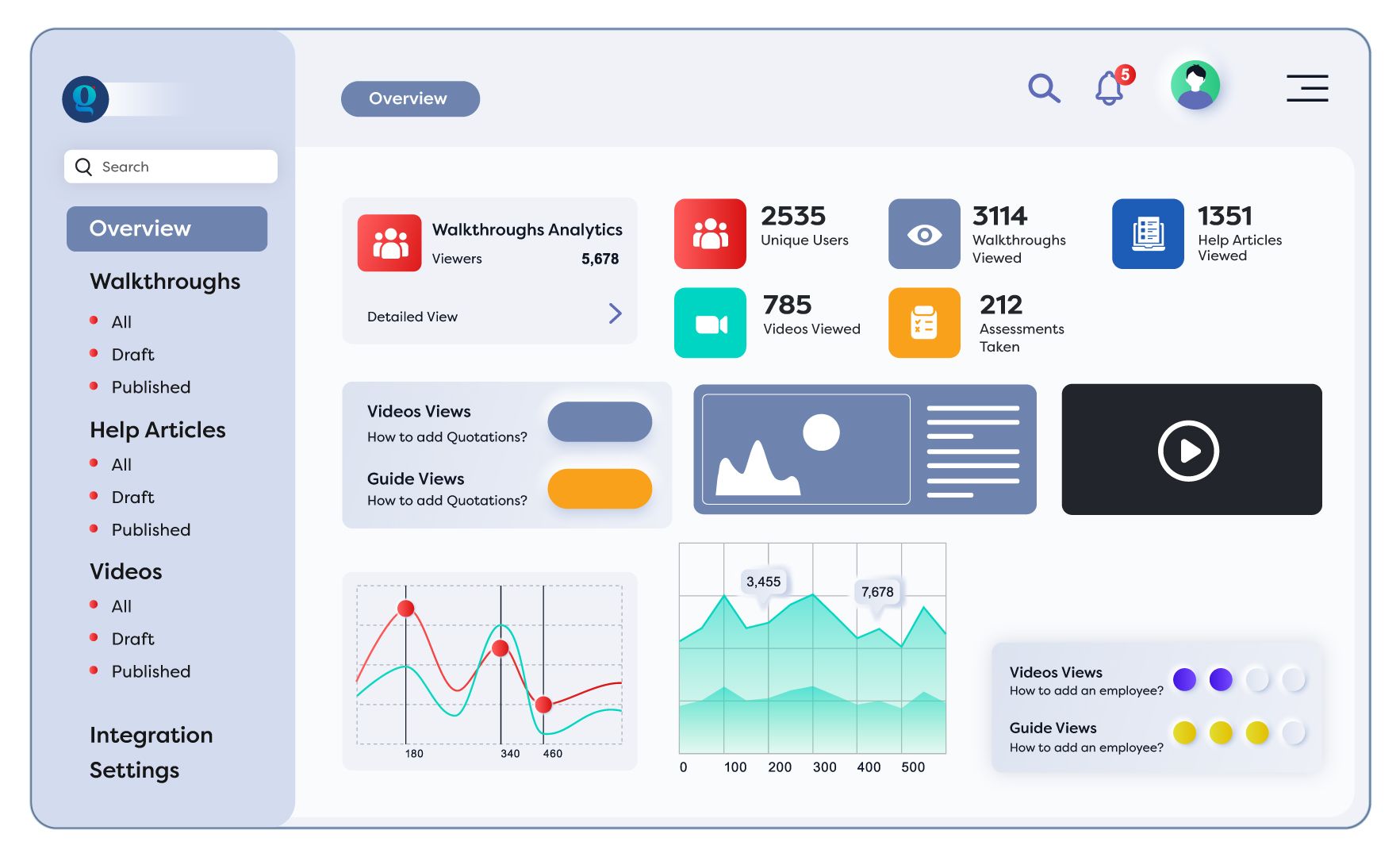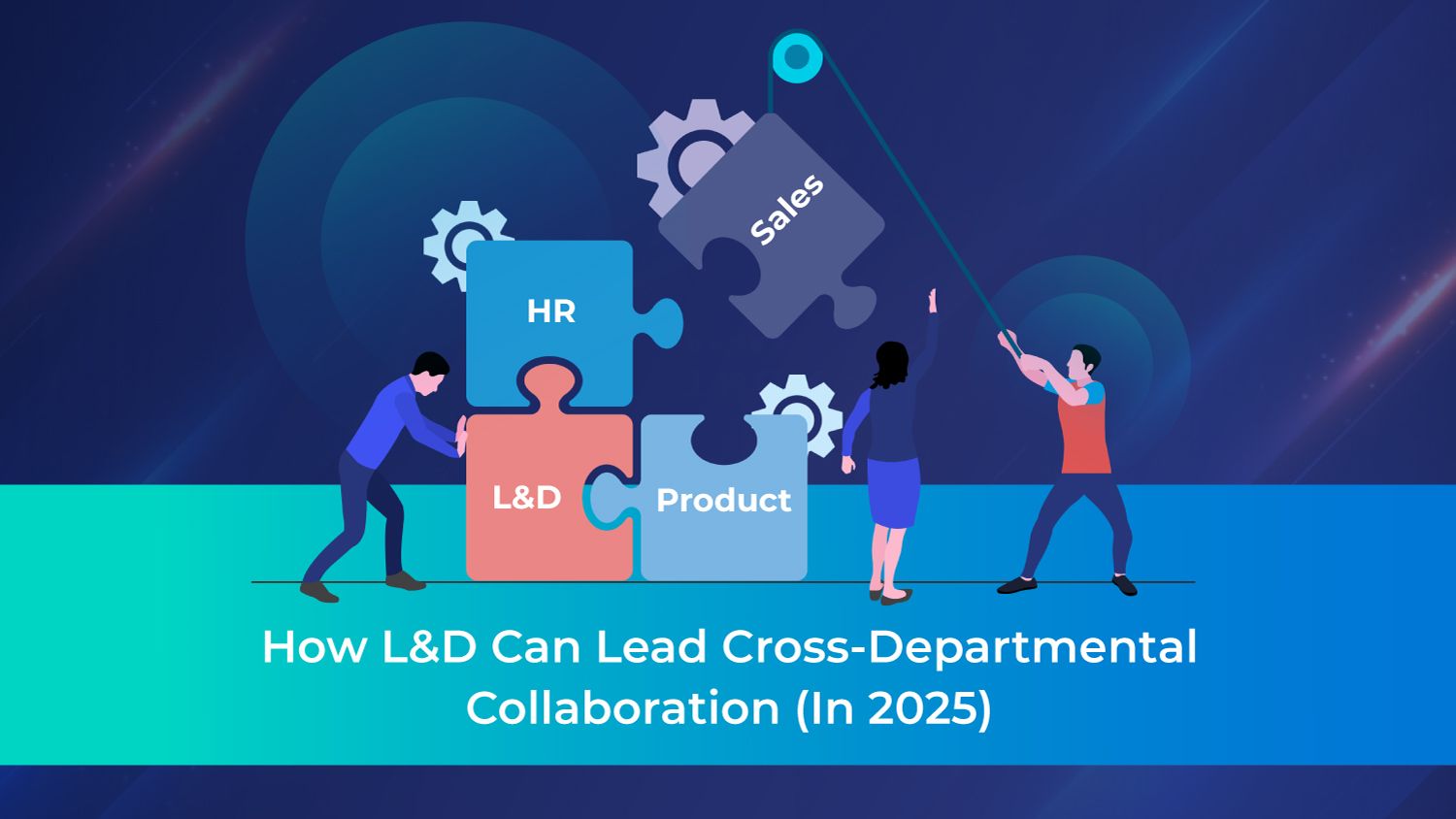If you've worked in Learning and Development (L&D), you know the cycle all too well:
A department requests training. L&D creates the resources. But when the training day arrives, the room is nearly empty.
Why does this happen? Are employees too busy to attend training sessions? Are managers holding them back, citing “critical deadlines”? Maybe.
But, let’s call it what it is: a visible lack of cross-departmental collaboration.
And guess who’s expected to solve it and keep things moving? Yes, it's the organization's L&D leaders, of course!
There are plenty of questions that come to mind when this phenomenon seems more common than rare. And, trust us, we had the same questions too!
- What is Cross-Departmental Collaboration in L&D
- Why Cross-Department Collaboration is the Backbone of Organizational Agility
- Where Does Collaboration Break Down Between L&D & Other Departments
- How Can L&D Build Partnerships With Other Departments
- How to Align L&D Programs with Departmental Goals
- 5 Tips to Build a Culture of Collaboration Through L&D
- Why L&D Collaboration Matters Most in Software Training
Now, let’s see a quick definition and get on the same wavelength!
What is Cross-Departmental Collaboration?
Cross-departmental collaboration simply means active cooperation between different teams or departments within an organization to achieve common goals and address shared challenges.
In the context of Learning & Development (L&D), cross-departmental collaboration is all about creating communication cycles & aligning teams to:
- address skill gaps,
- adopt new technology,
- deliver impactful training,
- optimize budgets,
- overcome resistance, &
- drive business success.
Why Cross-Department Collaboration is the Backbone of Organizational Agility
A New Rule Disrupts the Workflow
Imagine a financial services company with many employees working in different teams and departments.
One day, regulators announce a sudden rule: Customer verification must now follow ABC process instead of the current XYZ process.
Only challenge is all workflows are built around XYZ. Everyone, from field agents to backend teams, must now pivot. And fast.
Why This Needs a Cross-Functional Response
As the learning leader, you are responsible for making sure every employee understands and applies the new ABC process.
But this is not a job L&D can do alone. It takes a coordinated, cross-functional effort:
- Compliance: to interpret and explain the new rule
- IT: to update systems and workflows
- Operations: to adjust on-ground processes
- L&D: to train all concerned employees quickly and effectively
Success depends on everyone working together.
Collaboration Makes Agility Possible
This situation puts your organization’s agility to the test — how quickly can you respond to change?
Ask yourself:
- Are your systems flexible enough to handle sudden updates?
- Are your tools and workflows designed with adaptability in mind?
- Are all departments aligned and ready to act?
Bottomline: Collaboration across teams is SUPER ESSENTIAL. Get it right, and you enable fast alignment, confident execution, and customer trust. Get it wrong, and you're looking at delays, confusion, and compliance issues.
But more than that, collaboration shifts the mindset around change. When everyone moves in sync, agility becomes culture.
Where Does Collaboration Break Down Between L&D & Other Departments?
At first glance, it seems like employees understand the value of training. Most of them want to grow and learn. So where’s the gap?
Gap 1: Misaligned Priorities Across Teams
Each department operates with different goals, timelines, and pressures.
Managers, in particular, face a tough balancing act:
- Deliver results and hit KPIs
- Support team development
- Still find time for learning initiatives
As a result, training often gets pushed to the bottom of the list.
Gap 2: Technology Isn’t a Silver Bullet
L&D teams are under pressure to keep pace with rapid digital change.
Yes, tools like LMSs, LXPs, and authoring platforms offer scale and accessibility.
But they don’t solve deeper issues like:
- Unclear communication between departments
- No defined ownership of training responsibilities
- Misaligned expectations across teams
Even worse, training often lives outside the flow of work.
Employees have to dig through channels, jump between tools, or guess where to find answers. This leads to confusion and eventually, disengagement.
Gap 3: Content Overload at the Individual Level
When teams aren’t aligned, employees end up getting too much content and not always the right kind. This overwhelms learners, causes technostress and dilutes the impact of even high-quality material.
Without clear data on:
- What’s working
- What’s being completed
- What’s actually improving performance
…pushing more content just creates more noise.
To conclude on this point, each of these disconnects (organizational, technological, and individual) can be addressed with one solution: Better coordination between L&D, managers and their departments, and employees.
When priorities align, ownership is clear, and learning is delivered where it’s needed most, training becomes useful, timely, and actionable.
How to Build Partnerships With Other Departments
In the Gydebites podcast, Sameer Gupta, a Digital and Transformation PMO at Hero Fincorp with over 20 years of experience, shared two key point of views(POVs) to help L&D leaders address this disconnect:
- All departments naturally work in isolation.
- Every department has its own story to tell.
To get any digital intervention buy-in from teams like compliance and IT, you need to understand their reasons for resistance.
For example, compliance teams might wonder: “Will this weaken our checks?” “Will regulators question us?” “Does this make us look proactive?” Operational teams might worry about reconciliation gaps or financial risks.
As a L&D leader, your job is to see where they’re coming from. Address their doubts, build trust, and you’ll pave the way for smoother adoption, whether it’s for digital transformation, training, or any big change.
As a matter of fact, L&D collaboration across departments doesn’t just happen—it needs intentional effort.
How to Align L&D Programs with Departmental Goals?
Here are three steps you can take:
1. Build Cross-Functional Alliances
- Training works best (& is more fun) when it’s a team effort.
- Involve department heads in the training process from the start. Get their input on what skills are needed and how best to deliver the training.
- Learn about their specific goals, challenges, and priorities.
- You can use surveys, interviews, and focus groups to gather detailed information on what each department aims to achieve.
Storytime! A leading consumer goods company needed to update its marketing team’s skill set to keep pace with market trends. The L&D department didn’t start by guessing, it started by listening. Through interviews with marketing heads, they found a need for training in digital marketing techniques & data analytics.
Together, they co-created a training series tailored to these requirements. Soon, the marketing team became adept at using data to craft smarter, more targeted campaigns. This led to higher engagement rates, increased brand visibility, and a notable boost in market share.
You see how, ultimately, L&D collaboration with other departments supports business goals.
The bottom line:
By involving department heads early & gathering detailed information, you can create training programs that are perfectly aligned with the needs of the relevant department & the company as a whole.
2. Create a 'Learning in the Flow of Work' Culture
- Imagine if learning wasn't something you squeezed into your employees’ busy schedules but something that happened naturally as they worked. That's the idea behind "learning in the flow of work."
- As L&D, you can take this approach, but you have to make sure it's engaging and fun, as employees can easily get distracted if it's not relevant to their tasks.
- Especially when it is about software training (CRM training, POS training etc.), L&D teams can make ‘learning in the flow of work’ a must-do.
Wondering if it works in real life?
Companies like GoDaddy are already in. Their Global L&D Director, Cammy Wood, shared how they use a well-maintained LMS that lets their learners select courses from a curated catalog while at work. Plus, their training administrators can track enrollment & progress, which provides data points on engagement rates.
Here's an advice to create software training in the flow of work:
You can use a Digital Adoption Platform (DAP). Such platforms have easy-to-follow walkthroughs, quick how-to guides, and bite-sized videos embedded within the application. Your employees can easily access relevant software training material just-in-time!
3. Practice Flexible Scheduling
When L&D teams conduct Training Needs Assessments(TNA), they can understand employees' peak work hours, shift patterns, and available training windows for different teams.
Based on this, you can develop flexible training delivery models, such as:
- Blended learning approach: Combine classroom training, e-learning, and on-the-job training to accommodate diverse schedules.
- Modular training design: Break down training into smaller, microlearning modules that can be delivered flexibly.
- Self-paced learning options: Offer online courses and resources that employees can access at their convenience.
Ofcourse, you'll have to use online tools that support such an approach. These tools should ideally have analytics that allow you to track training attendance and completion rates for each learner. You can also collect their feedback and make the training content more relevant.
You might not get it perfect right away, but with practice, flexible scheduling can become a core part of your training strategy, helping more employees participate and benefit from learning opportunities.
5 Tips to Build a Culture of Collaboration Through L&D
L&D professionals work with people who have aspirations, fears, and a lot of potential. To bring out the best in each team member, L&D leaders need to create a work atmosphere that encourages strong interpersonal relationships.
Here are some tips:
1. Lead by Example
Great collaboration starts with leadership. L&D leaders (and functional heads) must model the behavior they want their teams to embrace.
Whether it’s showing up prepared, being open to feedback, or prioritizing continuous learning, leading by example sets the tone for how collaboration unfolds across the organization.
2. Communicate with Clarity and Respect
With everyone balancing competing priorities, clear and concise communication is critical. Avoid jargon and overly long messages.
Training documents should be easy to follow, with just enough detail to be actionable. When leaders respect their teams’ time and communicate purposefully, collaboration becomes much smoother.
3. Build Feedback Mechanisms That Drive Action
Feedback shouldn’t end with a form or performance review, it should spark conversations and lead to real improvements.
Actively seek input from other departments, listen to their challenges, and reflect their concerns in your learning design. When feedback is heard and acted upon, collaboration becomes two-way and trusted.
4. Use Smart Training Tools to Enable Knowledge Sharing
The right tech stack can make L&D collaboration more efficient and scalable.
- Learning Management Systems (LMS) - Ideal for structured content delivery and formal training programs.
- Digital Adoption Platforms (DAPs) - Great for on-the-job software guidance through walkthroughs and contextual help.
- Knowledge Base Platforms (KBs) - Perfect for storing internal documentation, technical resources, and process guides that any team can access, anytime.
Together, these tools help teams stay aligned, learn at their own pace, and access help when they need it most, without always turning to someone else for support.
5. Leverage Analytics to Fine-Tune Learning
Data is your ally when it comes to collaboration and impact. Tools like DAPs and LMSs offer rich analytics, right from tracking course completions to identifying where users drop off during a walkthrough. These insights help L&D teams:
- Identify learners who need extra support
- Understand which content is most effective
- Spot trends across departments
- Customize training to match real-time needs
With the right data, L&D can shift from reactive to proactive, delivering more relevant, timely, and strategic support across the business.
Bonus Key Recommendation: Conduct thorough User Acceptance Testing (UAT) before implementing any new technology. Make sure the tool:
- Is Easy-to-Use & Configure
- Aligns with organizational goals
- Meets specific learning and development needs
- Integrates quickly with existing systems
Remember: Technology is an enabler. When strategically selected and implemented, it can impacts learning effectiveness & overall organizational performance and collaboration.
Final Word: Why L&D Collaboration Matters Most in Software Training
One of the clearest signs of poor collaboration between L&D and other teams shows up during software adoption.
Organizations invest heavily in tools like ERP or CRMs, yet users skip key fields, mismanage data, or abandon the tool entirely. As a result, forecasting suffers and so does the business revenue.
Often, this happens because L&D is brought in too late. Training becomes a checkbox. Without early access or visibility, L&D can’t spot what’s actually going wrong. Clunky workflows, unclear field labels, or confusing processes stay hidden.
But when L&D collaborates early with business leaders and tool owners, they can shape support that is timely, relevant, and rooted in real user needs.
How Gyde Helps L&D Collaborate Better in Software Training
Gyde is an AI-powered Digital Adoption Platform (DAP) that helps users learn any enterprise software effortlessly, right within the application. It enables L&D teams and business functions to co-create just-in-time, in-app training tailored to their needs. Here's how:
1. Enables Real-Time, Contextual Support
Gyde lets L&D create:
- Audio-visual walkthroughs
- Contextual how-to articles
- In-app microlearning videos
All these help reduce dependency on IT or manuals, making support collaborative and self-serve.
2. Brings L&D into the Workflow (Not Outside of It)
As L&D create training using Gyde, their collaboration improves with:
- Business leaders (who define the workflows)
- Team admins (who understand system bottlenecks)
- End-users (who struggle with specific friction points)
No more isolated training modules. L&D becomes part of the day-to-day workflow support.
3. Uses Insights to Drive Better Training Content
Gyde’s analytics shows:
- Where employees drop off
- What help content is being viewed
- Which workflows or features are underutilized
L&D can then improve training content with tool owners that’s based on actual user behavior.

4. Supports Continuous, Collaborative Improvement
Unlike one-off training sessions, Gyde supports iterative training. So when a field changes or a workflow is updated, L&D can:
- Get input from the tool owner
- Update the walkthrough
- Push new content instantly inside the app
That’s true collaboration as it is fast, responsive, and co-owned.
TL;DR
Software training is most effective when it’s built collaboratively and delivered contextually.
Gyde helps L&D teams become proactive partners in driving software ROI by bringing training into the flow of work, where it matters most.
Early collaboration is L&D’s edge. Gyde helps sharpen it.
FAQs
What is an example of a cross departmental collaboration?
An example of cross-team collaboration is when the L&D team partners with the sales department to create a training program. The L&D team brings expertise in learning design, while the sales team provides insights on specific skills and challenges their reps face. Together, they design a training that’s tailored to real-world needs, making it more relevant and impactful. It’s a win-win!
How to measure cross-functional collaboration?
To measure cross-functional collaboration, focus on these key areas:
- Track how often teams are meeting or communicating. Regular check-ins signal strong collaboration.
- Gather feedback from team members on how effectively they’re collaborating. High engagement means collaboration is working well.
- Look at the results. Are projects delivered on time, within scope, and achieving the desired impact?
- Track how often departments are sharing resources, insights, and expertise with each other.
What are the challenges of cross-departmental collaboration?
- Communication breakdowns: Misunderstandings and lack of clear communication between teams.
- Different priorities: Departments may have conflicting goals or timelines.
- Limited resources: Teams often struggle to allocate time and manpower for collaborative efforts.
- Lack of alignment: Not everyone may be on the same page about the objectives or approach.
- Resistance to change: Teams can be hesitant to adopt new ways of working or collaborating.


